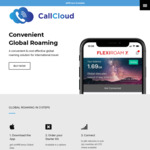EDIT For those of you without an eSIM enabled phone, we have microchip 'SIM sticker' kits that affix to your standard SIM enabling dual SIM functionality via the Flexiroam X App.
Standard SIM Cards also available, although they do not enable switching to & from your home SIM whilst travelling abroad.
For our coverage see: https://callcloud.com.au/pages/coverage
For our great value Local Data pricing see: https://callcloud.com.au/collections/local-data-plans
(more to be added soon)
CallCloud are an Australian based distributor of Flexiroam. We are offering 50% for the first 100 orders of our new eSIM. Priced at USD$20 from Flexiroam
If you have any questions please let us know.
More details below:
Are you a new Flexiroam user? Activate your eSIM profile and get permanent access to 580 mobile networks in over 150+ countries without switching SIM cards*! Manage your own account using our Flexiroam X app!
Things you can do using our app after you activate your account:
Check your data balance
Connect and disconnect from your Plan anytime
Activate Inflight Wi-Fi
Add Credits and top up more Global Data whenever you want
Purchase Local Data
Check the coverage in your favorite destination
Share your data with family and friends with Flexishare Learn more
*Currently supported devices: iPhone XS, XS Max, XR, Pixel 3, Pixel 3 XL
*Not supported by iPhone XR and XS Max purchased in Hong Kong, Macau and Mainland China
Same day activation, no contract required


I travel a lot and have been to many countries. Based on my experiences, I find that there are plenty of opportunities to use free wifi at a hotel or at a cafe. If you know how to use a VPN over DNS, then it's even better. Your actual internet traffic would be encapsulated in DNS query packets. Since most routers/firewalls do not block DNS queries, you are pretty much guaranteed to always be able to use the internet even if you run into a time limit. As long as you can connect to an access point, it will almost always work. There are plenty of alternatives too.
Furthermore, when I'm on a trip, I actually focus on taking photos or actually enjoying what the trip has to offer. I seldom ever need to access internet on my phone using 3G/4G/whatever. If you're doing that constantly, then you're not really enjoying your trip (unless you're using your phone for business, in which case it is common for companies to expense your mobile data anyway). Most hotels in most countries provide free wifi, so you could simply do all your internet activities when you're back at the hotel.
And a lot of travel apps these days provide offline access to your data. Google Trip, Sygic Travel, OneNote, Google My Maps, Google Maps, Here Maps, Maps.Me, CityMaps2Go, etc. If you do all your trip planning in OneNote, then you should have everything you need anyway. All my screenshots/photos/other information are stored in OneNote and I can just pull out my tablet and look at them on the go. So it's not like you require internet connectivity at all times, which is the only thing that is good about a 3G/4G connection using a SIM or e-SIM card.
Finally, there are plenty of deals on Klook (or alternatives) that provide more data per day. Here's an example:
https://www.klook.com/en-NZ/activity/1237-wifi-device-bali-i…
You simply pick it up at the airport, doesn't take more than 10~20 minutes of your time and you get to use a lot more data at a cheaper price. Having said this, these portable wifi hotspot devices aren't always good. If you do a bit of research, you'll find that some people complained about the lack of connectivity or slow speeds they were getting. Plenty of this can be found on TripAdvisor, or just about the device manufacturer/company in general.
For comparison, here's what you guys are offering for an Indonesian plan, @ $4.5 for 3 days with 1GB:
https://callcloud.com.au/products/indonesia-data-plans?varia…
1GB isn't really enough even for a few hours or for a day. You can't really do much with 1GB. Sure, you could purchase more data (at extra costs), but let's assume that someone were to buy this specific plan @ $4.5. That type of person would be someone who doesn't really require access to the internet constantly anyway, so why wouldn't they just do all the internet activities at a hotel with free wifi or something? Even using offline access apps? Why would they require this?
And considering that portable wifi hotspots generally have terrible reviews found online and that the connectivity is unreliable, how can you guarantee that people will get the speeds they are paying for when using your service? And what would be the use case for someone like me, who can get by on just free wifi or offline access apps?